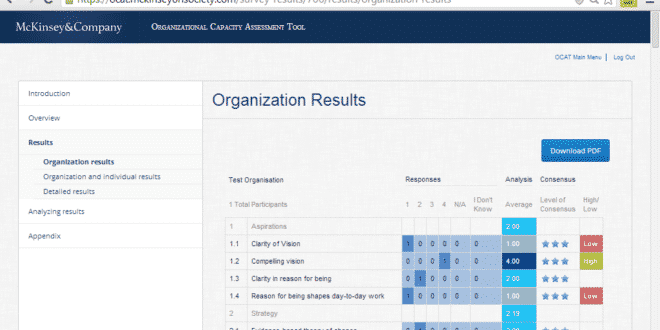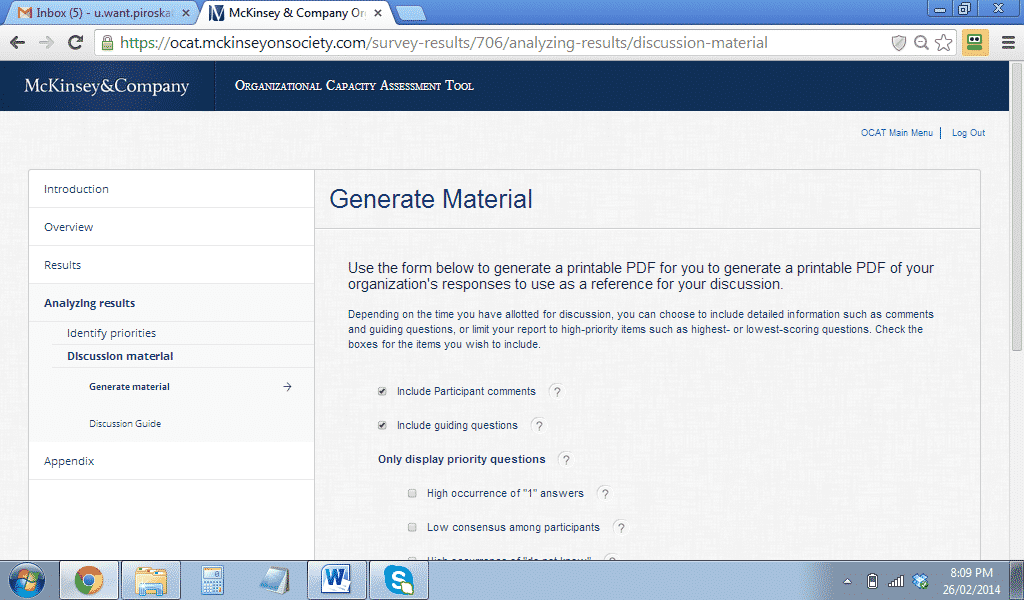Review Overview
Accuracy - 7
Ease of use - 5
Usefulness - 9
7
A free online tool to assess the strengths and weaknesses of your organisation.
International development programs often try to build the capacity of organisations. In some cases, donors try to help implementing organisations improve how they work. In other cases organisations themselves realise there is room to improve.
To help with this process the international consulting firm McKinsey & Company have developed the Organizational Capacity Assessment Tool (OCAT). In their own words OCAT is “a free online tool that helps non profits assess their operational capacity and identify strengths and areas for improvement.”
The McKinsey OCAT is not the only capacity assessment tool available. For other tools check out this list compiled by CADRI.
How does it work?
The OCAT is a standard survey which is completed by key people within your organisation. To start using the OCAT all you need to do it go to the OCAT website and follow these steps:
- Register your organisation – this is very simple and only takes a few minutes. You need to provide some basic details, such as where the organisation is located, funding sources, and size.
- Set the survey deadline – the survey itself is standard, so there’s no need for you to create the survey questions. All you need to do is say when it needs to be completed by.
- Invite survey respondents – Using the online system you can add the email addresses of everyone who should complete the survey. McKinsey recommend that this should be the leadership team, some or all of the board, and additional key staff members. It is not meant to be a survey of all staff.
- Take the OCAT – when you are ready, the online system will send an email to everyone who should complete the OCAT survey, along with the deadline for completion.
- See the results and set up a debriefing – Once everyone has completed the survey the OCAT system will generate a series of reports that you can use to identify strengths and weaknesses. It also provides recommendations on how to debrief with the people who completed it.
What is it like to use in practice?
To see how the OCAT works I ran a test analysis using a fictitious NGO. Registering for the online system, setting the deadline and inviting participants was quick an easy.
Once I received an email invitation to complete the OCAT all I had to do was click on a link in the email and the survey launched in my browser.
The survey was quite long. It had 123 questions divided in the following 9 sections:
- Aspirations
- Strategy
- Leadership, staff and volunteers
- Funding
- Values
- Learning and innovation
- Marketing and communication
- Managing processes
- Organisation, infrastructure and technology
All questions have to be completed before you can submit, although it is possible to move between sections and to save you work for later.
Normally I would be concerned about sending such a long survey to other people, but in this case I think it makes sense. McKinsey recommend that you only send the survey to key people in the leadership team and on the board. People in these positions should make time for this type of assessment (if they don’t then this might tell you something about their commitment to capacity building).
I was particularly impressed by the questions on leadership, financial management and risk mitigation. Many of these questions included things which NGOs often overlook.
However, I thought that the questions on monitoring and evaluation (M&E) were rather limited. They also called it “performance assessment data&rdquop; rather than M&E which could cause some confusion in International Development.
Some questions in the aspirations and strategy sections were quite long, with a lot of buzzwords. For example “Do we have a logical and commonly understood approach that reflects the most impactful way our organization can advance our vision and mission?” This made it difficult to know what the question meant, and could be a particular challenge for people who speak English as a second language.
What do the results look like and how can they be used?
After all the surveys were complete the OCAT system generated a range of different reports showing the results.
There are also some tools that allow you to analyse the results in order to identify the most appropriate next steps. For example, the tool below shows you the strengths and weaknesses of the organisation on one axis, and how much people agree or disagree on the other axis. This allows you to identify those areas that everyone agrees need to be improved, which is the easiest place to start capacity development.
McKinsey recommend that once all the surveys are complete you should have a debriefing session with everyone who completed it. The OCAT system can generate a range of printable documents and reports which you can use for the debriefing.
What are the limitations?
The purpose of the OCAT is to assess how your organisation is managed overall. It can’t find specific problems with your systems, or tell you whether your programs are technically sound. It is possible for an organisation to score very well on the OCAT, while at the same time be running programs that don’t work for technical reasons (I’ve seen this in practice many times).
Another limitation is that you need the Internet. When I tested the OCAT I was using a very slow Internet connection in a village in Malawi. This made the process quite frustrating and time consuming. If it’s not possible for you to use the Internet, anther options is the Marguerite Casey Foundation Organizational Capacity Assessment Tool. This tool is very similar to the McKinsey one, but can be completed in a spreadsheet.
Finally, the OCAT is only a self assessment. In some cases this can be very insightful. In other cases you might also want the opinion of an external consultant.
The bottom line
The OCAT from McKinsey & Company is a useful online tool to help your organisation assess its own strengths and weaknesses.
The OCAT is a good choice when:
- You want to assess the overall management of your organisation.
- Your leadership team and board have access to the internet, enough time to complete the survey, and are fluent in English.
- You want to know internal opinions.
The OCAT is NOT a good choice when:
- You want to assess the technical aspects of your programs, or your M&E system.
- Your internet is very slow.
- Your leadership team or board do not have much time available, or have limited English language skills.
- You want an external opinion.









